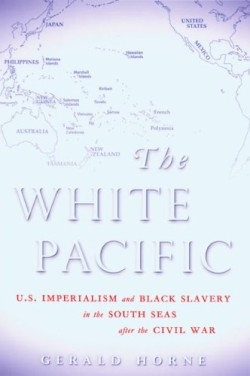The White Pacific
U.S. Imperialism and Black Slavery in the South Seas After the Civil War
The Emancipation Proclamation, the law that freed the slaves in the United States, was signed in 1863, but the dastardly institution lived on in the South Pacific until the late 1880s, driven by displaced southern slave owners and U.S. expansion. The thriving practice of “blackbirding,” the capture by force of indigenous island populations and their subsequent enslavement on large-scale plantations in the South Sea Islands, rose as slavery in the States fell.
Gerald Horne, Moores Professor of History and African-American Studies at the University of Houston, asserts in this book that the driving force of this lesser-known epoch was the Civil War and its outcome. “The end of slavery in the United States unshackled the industrial potential of this sizable nation, thus helping to create the surpluses and subsequent search for markets that so energized Secretary of State James Blaine and unleashed U.S. imperialism. This turning point in history also helped to create something of a ‘Confederate Diaspora’…”
The result was the horrendous practice of forcible importation of laborers into the cotton and sugar cane fields of Australia, Fiji, Hawaii, and many other islands. The plantation owners competed for their share of the worldwide market by keeping labor costs low. Beginning in the 1830s several hundred thousand people were stolen from small South Sea Islands and forced into virtual slavery. The struggle to supply cheap labor into the gaping maw of the plantation fields, coupled with the ideology of white supremacy, created an atmosphere of brutality and inhumanity.
Old rivals Britain, Germany, France, and the United States jostled each other during attempts to control global markets. Much of this jousting played itself out on the beautiful shores of Hawaii, including struggles with the rising Asian powerhouse, Imperial Japan. Horne follows the fortunes of the strategically located Hawaiian island chain, whose port provided coal and water supplies for trans-Pacific voyages. He documents its consolidation under an indigenous monarchy, through flirtations with various powers, the importation of non-free labor from other islands, the influx of Asian workers, and the power of influential whites—some former slave-holders, and some European expatriates.
While this incredibly well-researched book (each chapter has an average of 79 notes) leans toward the scholarly side, it uncovers a little-known chapter of the extension skin-color-based slavery into the late 1880s and the cancer of white superiority; it is well worth the time. However, the rich history of Hawaii, including U.S. machinations responsible for the overthrow of the indigenous monarchy, deserves its own meticulously researched book by Horne.
Reviewed by
Todd Mercer
Disclosure: This article is not an endorsement, but a review. The publisher of this book provided free copies of the book to have their book reviewed by a professional reviewer. No fee was paid by the publisher for this review. Foreword Reviews only recommends books that we love. Foreword Magazine, Inc. is disclosing this in accordance with the Federal Trade Commission’s 16 CFR, Part 255.

